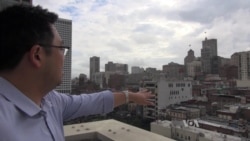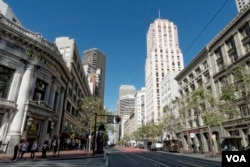California's high-tech center of Silicon Valley has expanded through the San Francisco Bay Area, bringing high-paying jobs and soaring rents. The companies headquartered there range from Apple, Google and Twitter to the ride-sharing service Uber and online business-services firm Salesforce.com.
Right or wrong, they are collectively being blamed for the region's housing crisis.
Yet San Francisco's historic Chinatown neighborhood has been coping with high housing costs for decades, and activists say the neighborhood demonstrates how cities can protect their communities through zoning regulations that maintain affordable housing.
San Francisco has the nation's highest median rental price for a one-bedroom apartment, according to the website Zumper, which tracks U.S. rental markets. The average rent in San Francisco is nearly $3,600 a month, more than 10 percent higher than the next highest market, New York City.
The soaring housing costs are the result of a booming economy and a growing technology industry.
Those exorbitant prices extend through the San Francisco Bay Area, to cities like San Jose in the heart of Silicon Valley, and Oakland across the bay, where speculators have bought some of the last of the region's affordable housing in industrial neighborhoods.
The tech workers live and work in the entire area, unlike decades ago when most worked in the Valley and lived in the urban centers. There are people with families who prefer living in the suburbs, and younger people who gravitate to the downtown area. They say the commute works both ways, since companies are housed in the city and suburbs, and that it's all considered Silicon Valley these days. There are people on commuter trains heading in both directions.
Volunteers from the Anti-Eviction Mapping Project gathered in Oakland on a recent evening to discuss the displacement of low-income and senior residents caught in the middle of powerful economic trends. They track and share the data, and the stories of those evicted, on a website.
Cofounder Erin McElroy says renters often are evicted on the flimsiest of pretexts in favor of tech workers in search of apartments.
“Landlords know that people can pay $3,000 or $4,000 a month who work in these [high-tech] industries. Affordable housing is being neglected and lost,” she said.
The activists include students, teachers and high-tech workers who share their concerns over gentrification and evictions.
They say the technology industry is not the only culprit. San Francisco tourism is at record levels, and demand also is increasing for hotel and office space.
Chinatown fights back
This battle has been fought before, as residents of Chinatown resisted encroachment by the city's financial district in the 1970s.
The International Hotel, home to hundreds of Philippine and Chinese American residents, was slated to make way for a high-rise development. Residents refused to leave and were forcibly evicted by the local sheriff's department.
The hotel was torn down, but the Catholic archdiocese worked with community groups to create affordable housing on the site.
Activists worked with city hall to create a plan, according to Malcolm Leung, deputy director of the Chinatown Community Development (CDC) Center, which owns and manages 26 properties in San Francisco, providing affordable housing to 3,000 low-income families and seniors. He stands on the roof of the 15-story complex, pointing to the densely packed buildings of Chinatown, and the towering financial services buildings around them.
“Chinatown exists to this day because that 1986 plan in essence protected Chinatown, restricted heights in the neighborhood. It restricted the kinds of uses in the neighborhood, and that's really what made sure that developers were disincentivized from buying these buildings up,” he said.
On April 6, Oakland halted for three months residential rent hikes on its older housing stock. San Francisco activists want a similar moratorium to help vulnerable renters.
Sasha Magee, an IT specialist for the U.S. government and a housing activist in his spare time, says measures like these will help residents with low incomes who live in older housing.
“Those are the folks who are getting most hurt by the crisis right now,” he said.
Activists say there are no easy solutions to the pressures of expansion, and Chinatown itself faces continuing pressures as land prices and rents soar in and around San Francisco.









